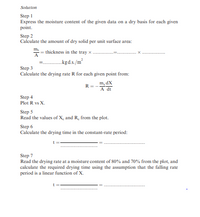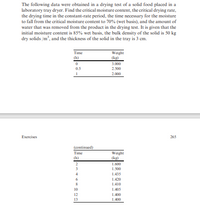
Introduction to Chemical Engineering Thermodynamics
8th Edition
ISBN: 9781259696527
Author: J.M. Smith Termodinamica en ingenieria quimica, Hendrick C Van Ness, Michael Abbott, Mark Swihart
Publisher: McGraw-Hill Education
expand_more
expand_more
format_list_bulleted
Question

Transcribed Image Text:Solution
Step 1
Express the moisture content of the given data on a dry basis for each given
point.
Step 2
Calculate the amount of dry solid per unit surface area:
ms = thickness in the tray x
А
..kgd.s./m²
Step 3
Calculate the drying rate R for each given point from:
m, dX
R=-
A dt
Step 4
Plot R vs X.
Step 5
Read the values of X, and R. from the plot.
Step 6
Calculate the drying time in the constant-rate period:
Step 7
Read the drying rate at a moisture content of 80% and 70% from the plot, and
calculate the required drying time using the assumption that the falling rate
period is a linear function of X.

Transcribed Image Text:The following data were obtained in a drying test of a solid food placed in a
laboratory tray dryer. Find the critical moisture content, the critical drying rate,
the drying time in the constant-rate period, the time necessary for the moisture
to fall from the critical moisture content to 70% (wet basis), and the amount of
water that was removed from the product in the drying test. It is given that the
initial moisture content is 85% wet basis, the bulk density of the solid is 50 kg
dry solids /m², and the thickness of the solid in the tray is 3 cm.
Time
Weight
(kg)
(h)
0
3.000
0.5
2.500
1
2.000
Exercises
265
(continued)
Time
Weight
(kg)
(h)
2
1.600
3
1.500
4
1.435
6
1.420
8
1.410
1.405
1.400
1.400
10
12
13
Expert Solution
This question has been solved!
Explore an expertly crafted, step-by-step solution for a thorough understanding of key concepts.
Step 1: To find and given.
VIEW Step 2: Express the given moisture content in the dry basis and calculate amount of dry solid per unit area.
VIEW Step 3: Plot X vs t.
VIEW Step 4: Calculate the critical drying rate and critical moisture content.
VIEW Step 5: Find the time necessary for the moisture to fall from the critical moisture content to 70%.
VIEW Solution
VIEW Step by stepSolved in 6 steps with 8 images

Knowledge Booster
Similar questions
- Distillation is an essential operation used commonly for the separation of materials in process engineering. Explain clearly how relative volatility can influence separation process by distillationarrow_forward21. A plate and frame filter press is used to filter a compressible sludge (S = 0.45) at 50 psia for 2 hours. Washing is done at 30 psi with wash water equal to 10% of the filtrate volume collected. The washing time is a. 100 min b. 127 min c. 85 min d. 205 minarrow_forward03: A wet solid is to be dried in a tray dryer under steady state conditions from a free moisture content of X₁ =0.4 kgH₂O/kg dry solid to X2 0.02 kgH₂O/kg dry solid. The dry solid weight is 99.8kg dry solid and the top surface area for drying is 4.645m². the drying rate curve can be represented by Figure below. a- Calculate the time for drying using graphical integration in the falling rate period. b- Repeat but use a straight line through the organic for the drying rate in the falling rate period. Drying rate 20 0.8 0.4 Falling rate Constant rate 0.1 0,2 0.3 0.4 0.5 0.6 Free moisture X (kg H, O/kg dry solid)arrow_forward
- During flour milling, wheat grains are taken at a rate of 4 t/h and goes to the cleaning system. As a result of cleaning, 2% is removed in the form of foreign material and chaff. The cleaned grain is then tempered (moisture adjusted from initial to higher moisture to make the bran layer rubbery) before they pass through roller breaks. If the initial moisture content of of the grain is 13.2%, determine the weight of tempered grains if the tempering moisture is 14.5%. Determine the amount of water adsorbed during tempering per tonne of tempered grain. (Moistures are given in wet basis). Also, determine the amount of foreign material/chaff generated per tonne of tempered grain.arrow_forward17.5. Identify the following polymer processing techniques as either: (i) Continuous (able to operate for very long periods of time as long as enough polymer is supplied), (ii) Batch or semi-continuous (able to make one material at a time, or possibly operate in a cyclic or fashion for a long time with small breaks between processing) THERMAL EXTRUSION CASTING TO FORM A THERMOSET POLYMER BLOW MOLDING MELT SPINNING OF FIBERS THERMOFORMING - INJECTION MOLDING - BLOW EXTRUSION - CALENDERING - COMPOUNDING - ROTATIONAL MOLDING 17.6. You work at a plant that makes poly(ethylene terephthalate), PET, bottles using blow molding, but the production line is having a problem with lots of rejected bottles, which must be ground up and recycled. The rejected bottles sometimes have holes in the threaded part at the top of the bottle (where the screw-cap goes), or this part is often too thin and not rigid enough for the screw cap to fit snugly. A. Give a likely explanation of what is causing the…arrow_forwardIn the dryer models for a belt dryer with throughcirculation and a direct-heat rotary dryer, is the rate of drying based on heat transfer or mass transfer? Why?arrow_forward
- Under what drying conditions is the moisture-evaporation temperature equal to the wet-bulb temperature?arrow_forwardCalculate using the data below the % ash of the sample (dry basis). Weight of sample before drying: 12.6758 g Weight of the sample after drying: 9.5672 g Weight of the sample after ashing: 1.9875 g Round off to 4 decimal places and do not include units.arrow_forwardDeterioration must be strictly avoided when drying pharmaceutical products. Furthermore, such products are often produced from a nonaqueous solvent such as ethanol, methanol, acetone, etc. Explain why a closed-cycle spray dryer using nitrogen is frequently a good choice of dryerarrow_forward
arrow_back_ios
arrow_forward_ios
Recommended textbooks for you
 Introduction to Chemical Engineering Thermodynami...Chemical EngineeringISBN:9781259696527Author:J.M. Smith Termodinamica en ingenieria quimica, Hendrick C Van Ness, Michael Abbott, Mark SwihartPublisher:McGraw-Hill Education
Introduction to Chemical Engineering Thermodynami...Chemical EngineeringISBN:9781259696527Author:J.M. Smith Termodinamica en ingenieria quimica, Hendrick C Van Ness, Michael Abbott, Mark SwihartPublisher:McGraw-Hill Education Elementary Principles of Chemical Processes, Bind...Chemical EngineeringISBN:9781118431221Author:Richard M. Felder, Ronald W. Rousseau, Lisa G. BullardPublisher:WILEY
Elementary Principles of Chemical Processes, Bind...Chemical EngineeringISBN:9781118431221Author:Richard M. Felder, Ronald W. Rousseau, Lisa G. BullardPublisher:WILEY Elements of Chemical Reaction Engineering (5th Ed...Chemical EngineeringISBN:9780133887518Author:H. Scott FoglerPublisher:Prentice Hall
Elements of Chemical Reaction Engineering (5th Ed...Chemical EngineeringISBN:9780133887518Author:H. Scott FoglerPublisher:Prentice Hall
 Industrial Plastics: Theory and ApplicationsChemical EngineeringISBN:9781285061238Author:Lokensgard, ErikPublisher:Delmar Cengage Learning
Industrial Plastics: Theory and ApplicationsChemical EngineeringISBN:9781285061238Author:Lokensgard, ErikPublisher:Delmar Cengage Learning Unit Operations of Chemical EngineeringChemical EngineeringISBN:9780072848236Author:Warren McCabe, Julian C. Smith, Peter HarriottPublisher:McGraw-Hill Companies, The
Unit Operations of Chemical EngineeringChemical EngineeringISBN:9780072848236Author:Warren McCabe, Julian C. Smith, Peter HarriottPublisher:McGraw-Hill Companies, The

Introduction to Chemical Engineering Thermodynami...
Chemical Engineering
ISBN:9781259696527
Author:J.M. Smith Termodinamica en ingenieria quimica, Hendrick C Van Ness, Michael Abbott, Mark Swihart
Publisher:McGraw-Hill Education

Elementary Principles of Chemical Processes, Bind...
Chemical Engineering
ISBN:9781118431221
Author:Richard M. Felder, Ronald W. Rousseau, Lisa G. Bullard
Publisher:WILEY

Elements of Chemical Reaction Engineering (5th Ed...
Chemical Engineering
ISBN:9780133887518
Author:H. Scott Fogler
Publisher:Prentice Hall


Industrial Plastics: Theory and Applications
Chemical Engineering
ISBN:9781285061238
Author:Lokensgard, Erik
Publisher:Delmar Cengage Learning

Unit Operations of Chemical Engineering
Chemical Engineering
ISBN:9780072848236
Author:Warren McCabe, Julian C. Smith, Peter Harriott
Publisher:McGraw-Hill Companies, The